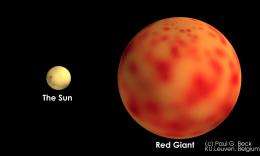Astronomers reveal a rapidly spinning core inside old stars

(PhysOrg.com) -- Scientists have made a new discovery about how old stars called 'red giants' rotate, giving an insight into what our sun will look like in five billion years.
An international team of astronomers led by PhD student Paul Beck from Leuven University in Belgium have managed to look deep inside some old stars and discovered that their cores spin at least ten times as fast as their surfaces. The result appeared today in the journal Nature.
It has been known for a long time that the surfaces of these stars spin slowly, taking about a whole year to complete one rotation. The team has now discovered that the cores at the heart of the stars spin much faster with about one rotation per month. The discovery was made possible because of the ultra high precision of the data from NASA's Kepler space telescope.
Beck and his collaborators analysed waves travelling through the stars, which appear at the surface as rhythmic variations in the stars' brightness. The study of such waves is called asteroseismology, and is able to reveal the conditions deep inside a star which would otherwise remain hidden from view. Different waves probe different parts of the star and by a detailed comparison of the depth to which these waves travel inside the star, the team found evidence of the rotation rate and its dramatic increase towards the stellar core. “It is the heart of a star, which determines how it evolves," says Beck, "and understanding how a star rotates deep inside helps us to understand how stars like our Sun will grow old."
.jpg)
The stars studied in the article are so-called red giants. Our Sun will become a red giant in about 5 billion years. Their outer layers have expanded to more than 5 times their original size, and cooled down significantly so that they appear red. Meanwhile, their cores did exactly the opposite, and have contracted to an extremely hot and dense environment. To understand what has happened to a star’s spin consider what happens to an ice skater performing a pirouette. A spinning ice skater will slow down if the arms are stretched far out, and will spin faster if the arms are pulled tightly to the body. Similarly, the rotation of the expanding outer layers of the giant has slowed down, while the shrinking core has spun up.
The Kepler space telescope, is one of NASA’s most successful current space missions. Designed to search for Earth-size planets in the habitable zone of distant stars, the mission has detected numerous planetary candidates, and has confirmed many bona fide planets outside our solar system. Kepler is capable of detecting variations in a star’s brightness of only a few parts in a million, and its measurements are therefore ideally suited to detect the tiny waves mentioned above. The effect of rotation on these waves is so small, that its discovery needed two years of almost continuous data gathering by the Kepler satellite.
More information: Fast core rotation in red-giant stars as revealed by gravity-dominated mixed modes, DOI:10.1038/nature 106212
Provided by Leuven University





















